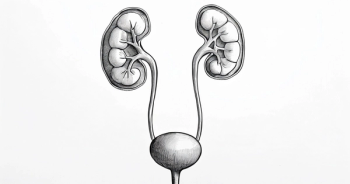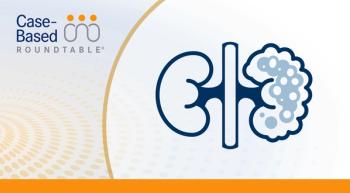
Peers & Perspectives in Oncology
- May 2025
- Pages: 25
Barata and Participants Discuss Second- Line and Later Options in RCC
During a live event, Pedro C. Barata, MD, MSc, discussed the case of a patient with advanced clear cell renal cell carcinoma who requires second-line therapy.
EVENT REGION Indiana, Michigan, and Ohio
PARTICIPANT LIST Christopher Wee, MD | Tarek A. Chidiac, MD | Weiquan Lu, MD | Fadi E. Nakhl, MD | Neeraj Mahajan, MD | Deepa B. Jagtap, MD
Barata: When you think of the second line, you have a big list of things you can consider and prioritize. There’s no right or wrong answer. We all prioritize things when we are choosing treatment. What came to mind when you saw this patient in the second line post cabozantinib/ nivolumab at 14 months? What is the priority here? What do you think is the most important thing?
Wee: Overall survival is always the most important priority, but we have no head-to-head data with any of these options. So, I think [about whether] this is progressing fast—it sounds like he’s getting multiple new spots and is symptomatic—or it is progressing slowly. If he has a good performance status, I would probably do lenvatinib [Lenvima]/everolimus. It seems to have a better response rate. With belzutifan [Welireg] by itself, you’re looking at 20% to 30% [survival], so that’s why I probably would try lenvatinib/everolimus and see if we can get some mileage out of a second tyrosine kinase inhibitor [TKI].
Barata: If a patient is progressing on 14 months of cabozantinib/nivolumab, what’s your perception? Is that fast? Is that slow? What are you thinking?
Wee: A little bit faster than I would want, but not the worst.
Barata: It’s a fantastic point because the median time to progression with cabozantinib/nivolumab was around 16 months.1 So it appears that this patient is now progressing faster than half of the people on the trial with cabozantinib/nivolumab on CheckMate 9ER [NCT03141177], so that’s a great point. So lenvatinib/everolimus because you’re thinking [about a] better response rate, you don’t have overall survival data, and the patient can tolerate it.
Wee: Anecdotally, I’ve had people do that after cabozantinib/nivolumab, and it worked.
Barata: Prior experience, fair enough. What was your thought process about what to do at this point?
Chidiac: I would go to a therapy that he didn’t have before. I would likely use doublets in this case. I would do everolimus and lenvatinib. If [his] performance status was worse, then I would have done a single agent.
Barata: Do you have a preference?
Chidiac: My preference is to use a doublet when they have a good performance status because I’m not going to be able to use that later.
DISCUSSION QUESTION
- What is your reaction to the data from the phase 3 TiNivo-2 study (NCT04987203) of tivozanib (Fotivda)?
Lu: I haven’t used this medication yet, but I think the data is very informative and answers some questions—not only whether we are challenging the inhibitor. I found that the one interesting point from the data is [about] the most recent prior therapy. It seems like this is affecting the efficacy of the medication, and that…will help me to make the decision whether we use this as a later line, or we move this ahead.
Barata: When you look at the data, and you see things such as patients who didn’t get a TKI [before] they enrolled in the trial, let’s say [they received an immune checkpoint inhibitor with] ipilimumab [Yervoy] plus nivolumab—it was 9.2 months for progression-free survival, with tivozanib monotherapy.2 The number drops a bit when patients were exposed previously to a TKI. Do you think those numbers are active enough to say you might consider it in the second line?
Lu: Yes, that’s what I’m thinking.
Nakhl: We use tivozanib for some patients, definitely. For 6 to 7 months, they were basically on tivozanib, and then the disease progressed after that. I don’t have [any] patients currently on tivozanib for more than 6 months. We know that the second immunotherapy may be a problem to rechallenge. I feel that cabozantinib has better activity in the second line, and that’s why I try to keep it for the second line and use axitinib [Inlyta], or start with nivolumab/ipilimumab first, and then maybe add cabozantinib to nivolumab. After that, keep nivolumab and maybe add cabozantinib to it. What do you think?
Barata: So you’re thinking of cabozantinib following checkpoint inhibition as your TKI of choice because [the patient] can handle it well, and you see activity?
Nakhl: And keep it with nivolumab after failure of ipilimumab/ nivolumab? If your patient is on nivolumab, can you add cabozantinib to that and keep going?
Barata: That’s a great question. The data with salvage immunotherapy kind of…discourages us from keeping [patients] on the immunotherapy. But I think the pattern of going with cabozantinib as one of the preferred second-line options is very reasonable. That’s what most people think of doing. Whether you keep the immunotherapy or you [use] another immunotherapy, I think that’s probably going to change over time because of the tivozanib data. Do you think the data are enough to convince you to say, “I’m not sure I’m going to help my patient by keeping the nivolumab, but I know I might bring more toxicity.” Do you see it that way?
Nakhl: I think differently because I feel like nivolumab may have done some work [but it] wasn’t enough. And then, especially because cabozantinib is so active, I like to keep it on top of it. If the patient has a good performance status, we’re not talking about getting out of toxicities from immunotherapy and keep pushing that; that will not be the smart thing to do.
I have a male patient who’s 48 years old, and this is what happened to him, and he’s still doing well now. Maybe you’re right; maybe nivolumab shouldn’t be continued. But I started nivolumab/ipilimumab, and then he was on maintenance, and the minute ipilimumab was stopped, the patient showed some activity in the lung. It wasn’t that bad of an activity, so I added cabozantinib to the nivolumab and kept him going. He’s so active, so I’m not sure [whether] we’re getting anything from nivolumab.
Barata: There’s a trial called PDIGREE [NCT03793166] that gave nivolumab/ipilimumab to everyone, and then, depending on whether patients aren’t responding with a complete response and are not progressing, they are randomly assigned to nivolumab or cabozantinib/nivolumab. There are not progressors; they have to have stable disease or partial response. But if they do, we will find out if adding cabozantinib at that point or only later is helpful or beneficial. That trial [has more than] 1000 patients. It’ll probably read out in the next year or two, and we’ll get that answer. So stay tuned for that because that’s a fantastic thought.
Mahajan: In both TIVO-1 [NCT01030783] and TIVO-3 [NCT02627963], investigators choose sorafenib [Nexavar], which is an old, beaten-up drug, as a comparator. [However,] both trials did not show overall survival, both in the first line and later lines. So, I’m not sure, trying to compare it with sorafenib, how much we can say?
Barata: Sorafenib is an old drug. When belzutifan was compared with everolimus, did you feel the same way? Would you say the way the studies are designed in this setting, so late, we’re comparing [when] drugs are old or, or you see everolimus differently than you see sorafenib?
Mahajan: At least everolimus was still a third-line drug. Sorafenib was done a long time ago. Nobody will use sorafenib in the third line after cabozantinib or sunitinib [Sutent], or any of them.
Barata: So, for you, the control arm matters. It’s something that came to mind. For the TIVO-3 data, with sorafenib on the control arm, what crossed your mind? Did you think that the activity for tivozanib wasn’t that good because the comparator is sorafenib?
Mahajan: I think the progression-free survival of 5.6 months with the HR of [0.73] was impressive.3 But if it cannot beat sorafenib in overall survival, then you start [questioning] how much [of a] different or new TKI it is.
DISCUSSION QUESTIONS
- From the TIVO-3 and TiNivo-2 datasets, what efficacy parameters stand out about tivozanib?
- What conclusions do you draw (eg, about TKI dosing)?
Barata: Do you think this is practice-changing? Does that make you see tivozanib as a stronger option or a weaker option?
Jagtap: I haven’t had a chance to use tivozanib yet but I’ve heard a lot about it, and definitely the data were very interesting. I’m in the thought process of using your best [option as] the first and the most aggressive treatment because I think about 50% of your benefit comes from your first line of treatment in the whole spectrum of how long the patient is expected to be on any treatment.
I tend to favor ipilimumab/nivolumab dual immunotherapy first, and then cabozantinib is a very good option in the second line. I would definitely consider either tivozanib or belzutifan thereafter. But I’m a little disappointed to see that in the third line, [tivozanib] tends to give probably about 5 to 6 months of benefit. That’s where I may consider adding an everolimus-based doublet agent if the patient has a good performance status and can handle it. So that may be one place I may go back to a dual therapy before going to tivozanib, which may still be a fourth-line option.
DISCLOSURES: Barata previously reported financial relationships with AstraZeneca, AVEO Oncology, Bayer, Bristol Myers Squibb, Caris Life Sciences, Eisai Co, EMD Serono, Exelixis, Merck, and Pfizer Inc; institutional relationships with Dendreon Pharmaceuticals, AstraZeneca, Bayer, Caris Life Sciences, Merck, and Pfizer Inc/Astellas Pharma; and has received institutional research funding from AVEO Oncology, Blue Earth Diagnostics, Exelixis, Merck, and Pfizer Inc.








































